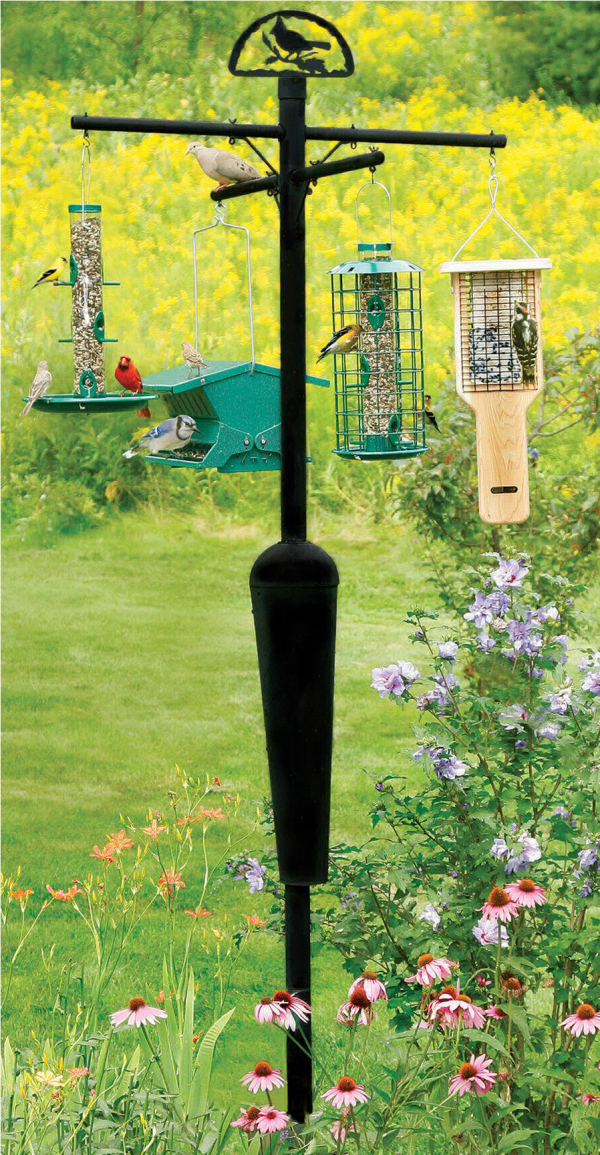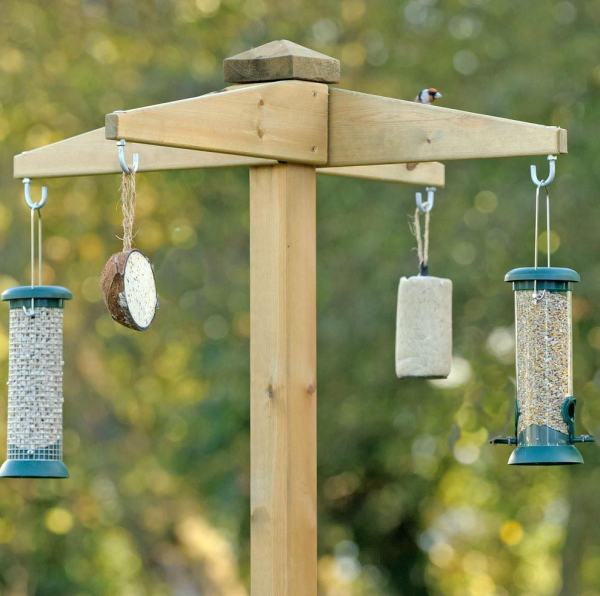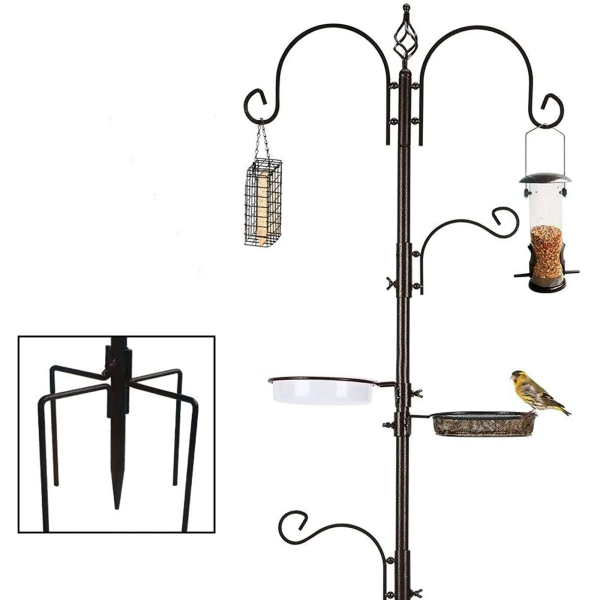
A pole-based feeding station in use that has a squirrel baffle attached.

This wooden feeding station is a homemade pole system that offers many options for hanging feeders and waterers, and new hooks can easily be added when needed.

An ornate metal pole system showing platform hangers for a bird bath and a platform feeding dish, along with an example of a sturdy anchoring base to push into the ground.
|
An organized, clean, well-stocked feeding station adds a lot to our yard and benefits birds in the best possible ways. To organize a number of different feeders in a relatively concise location that looks good too, most birders use feeder poles, hangers, and stands. A single feeder pole with a few hangers spaced out on opposite sides can be a big plus to create an attractive, well-organized feeding station. You can also install a shepard’s hook or 2 for additional hanging feeders as needed, and a metal or wooden stand can hold a platform feeder or bird bath.
Let’s start with a centralized pole system with multiple hangers, some positioned at different levels with others positioned on different sides of the pole. Many pole systems are available from birding equipment suppliers like Brome, Duncraft, Wild Birds Unlimited, and others. They are easy to install pole mounting systems that anchor in the ground, and with most models you can add more hangers to essentially create your own personalized feeding station pole.
Some pole systems are quite economically priced, and most of them are anchored by long stakes that are extensions of the pole that you push deep into the ground. These pole systems are really the best bet for organizing your feeders and bird bath at a central location and they allow you to add your own touches. Some even come with their own feeders, water basins, a squirrel baffle, and more – in case you decide to renew your feeding station, or if you are just starting to expand your interest in feeding birds.
On a smaller scale, shepard’s hooks are especially handy because they are easy to add or remove as needed, such as when seasons change or when you add a new feeder. They also permit you to reposition feeders or hanging waterers easily. Shepard’s hooks come in different sizes too, which is handy if you want to position feeders at different heights. You might even be able to find different colors of shepard’s hooks, or you can paint them any color you wish. Found in the same location of a garden store or hardware store, another option is to use a metal or wooden stand to support a clay dish to use as a platform feeder or bird bath.
Positioning
Most birders already have their feeding station positioned in just the right place, but in case you are interested in a change or improvement, or if you are just starting out, positioning your feeding station can be a matter of finding just the right location to view it from a preferred window or windows. Most birders like to keep their feeding station in an open location, at least 12 feet from the nearest tree, fence, or other launching pad to keep squirrels from jumping to your bird feeders.
It’s also probably best to keep your feeders positioned close to windows, less than 8 feet, so if a bird makes a mistake and flies into your window, it will not have the velocity to harm itself. Or you can position the feeding station far enough away so birds don’t interact with windows. Otherwise, a window treatment to keep birds from flying into windows is another option.
Another thing to keep in mind when positioning feeders is to optimize the chances for taking photographs from the best angles with relation to the sun. If you tend to take a few photos during the morning or late afternoon, position a feeder to take advantage of the morning or afternoon sunlight. That is, position the feeder so you are photographing with the sun behind you.
We also add a couple natural perches a few feet away from our feeding station to provide a place where birds can perch as they approach a feeder, or as they wait their turn to feed or drink. We simply find a sturdy bare branch and thrust it vertically into the ground, or attach it to an anchored shepard’s hook for added stability. The top of the branch can also provide a nice perch where you can photograph the birds that perch there while visiting your feeders and bird bath.
A rather novel idea: While most feeding stations are fairly well concentrated in a single area, there is nothing to say that you can’t spread the wealth throughout your yard – that is, to position different feeders and water features in different locations around your property. I’m sure we aren’t the first to think of this idea, but it’s something to consider doing in addition to your feeding station too.
It’s second nature to point out that it’s important to keep your feeders clean, and the area below and around your feeding station clean too. We prefer to feed shelled seeds and peanut halves to avoid a ground-based mess; and keep your water fresh too. As you know, feeding birds is at least a daily regimen, a welcome one, and it’s important to make your feeding station a reliable source of food and water, especially during the midst of the winter season. But throughout the year you can attract resident, wintering, migrating, and nesting birds by providing a reliable source of foods and water. It’s one of the great things that we all enjoy about birding, and backyard birding in particular.
Share your backyard birding experiences and photographs with The Birding Wire at editorstbw2@gmail.com